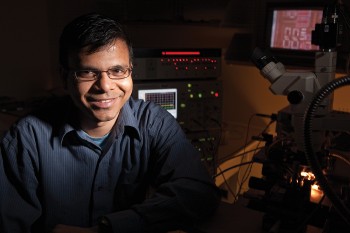COVER STORY SIDEBAR


Ph.D. student Rajeev Dokania See larger image
Fireflies in Southeast Asia are able to blink in unison across entire tracts of forest. It happens because each firefly watches its immediate neighbors light up, then adjusts to match them.
Electrical and computer engineering Ph.D. student Rajeev Dokania wants to apply this type of locally generated synchronicity to radios. Dokania came to Cornell in 2005 and received a prestigious Intel Foundation Ph.D. Fellowship, which funded technical and professional mentors in the company.
Under the direction of his adviser, associate professor Alyssa Apsel, Dokania is part of a team that is pairing sensors with low-power radios. When connected as a network, these radio nodes can detect data in their immediate environments and then synchronize their signals to share data across large areas.
Apsel's lab received more than $650,000 from Lockheed Martin Corp. to support this work. The company hopes to apply the technology in areas such as border security, infrastructure monitoring and environmental sensing.
"Border intrusion motion detectors could be networked to communicate with each other about disturbances they detect," thus forming a responsive line of security over long, unmanned distances, Dokania explains.
This type of network isn't in place today because existing technology is bulky and saps batteries too quickly.
"If radio nodes can harvest energy from the environment, such as solar energy, and the power requirement is low," Dokania says, "then you can make the entire unit very small -- something like one cubic centimeter."
So far his team has conducted three trials and succeeded in designing a radio that consumes only 20 microwatts -- one-tenth of what current radios require. They ultimately want to achieve a battery life of about 10 years.
In contrast to government agencies that fund research, Lockheed Martin stays closely involved in the process. "They come to see our progress, and we demonstrate how things are working out and what problems we are solving," says Dokania. "Sometimes we discuss needs for specific applications they would like. One of the patents we are in the process of filing came about this way."
Companies can gain new ideas, patents and products when they partner with researchers in academia, but they also benefit by demonstrating leadership. They fund "projects they would be proud to associate themselves with," Dokania says. Sponsoring research also promotes access to a pool of talented students, some of whom may follow their projects into the private sector after graduation.
The university benefits from increased funding for its students and research. "Partnerships with industry can also catalyze new thinking about problems and provide mechanisms for translating discoveries directly into society," says Abby Westervelt, director of corporate and foundation relations in the College of Engineering.
For Dokania, there's a personal reward as well.
"It helps me to think, 'OK, what I am doing has a future.' That helps me keep motivated and working toward the final goal."
